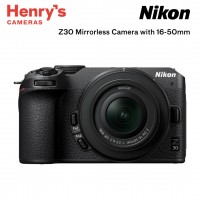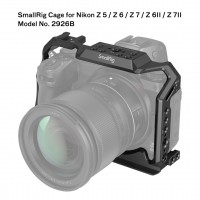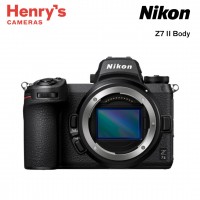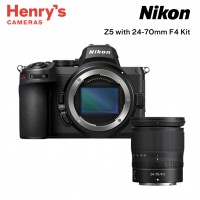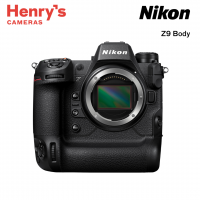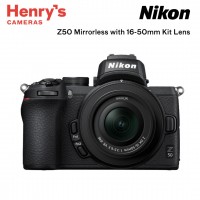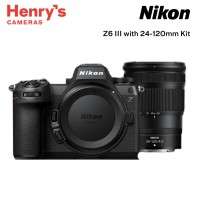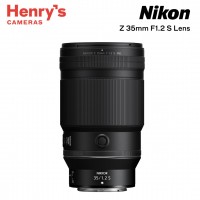Nikon Z6 III Body
Nikon
-
₱146,900.00
- ₱186,900.00
- -21%
- 0% 3mos BDO, BPI, UNIONBANK, HSBC ₱48,966.67/mo.
- 24.5MP Partially-Stacked CMOS Sensor
- EXPEED 7 Image Processor
- 6K 60p N-RAW, 6K 30p ProRes RAW
- 4K 120p, Full HD 240p Slow Motion Video
- Up to 20 fps Raw, 60 fps JPEG Shooting
- Blackout-Free, 5760k-Dot EVF
- 493-Point AF, AI-Based Subject Detection
- 3.2" 4-Axis Tilting Touchscreen LCD
- CFx Type B & SD Memory Card Slots
Accessories
| Interface | Video: 1x HDMI (Unspecified Signal) Input, Video: 1x 1/8" / 3.5 mm TRS Stereo Headphone Output, 2x 1/8" / 3.5 mm TRS Stereo Microphone Input, Power: 1x USB-C Input, Other: 1x USB-C Data Output (Shared with Power Input) 1x Nikon DC2 |
Imaging
| External Recording Modes | HDMI: UHD 4K (3840 x 2160) |
Camera/Video Camera
| Display | 3.2" 2.1m-Dot Tilting Touchscreen LCD |
| Megapixel & Sensor | Actual: 26.79 Megapixel, Effective: 24.5 Megapixel (6048 x 4032), 35.9 x 23.9 mm (Full-Frame) Partially Stacked CMOS |
| Viewfinder | 5,760,000 Dot Built-In Electronic Viewfinder |
General
| Warranty | 2 Years Nikon PH Warranty |
24.5MP Partially-Stacked CMOS Sensor
- Top continuous shooting speeds of 20 fps when shooting in raw, up to 60 fps when shooting in full-frame JPEG, and 120 fps when shooting JPEGs using a DX crop, with all rates supporting full AF/AE performance.
- Able to buffer over 1000 images in a burst when using the electronic shutter, meaning image sequences can be recorded for approximately 50 seconds continuously.
- Pre-Release Capture at up to 120 fps helps make decisive moment shots easier by recording frames in a burst for up a second prior to actually releasing the shutter. When this feature is activated, burst shooting will commence when the shutter is half-pressed and the buffer will retain up to 3 seconds' worth of frames prior to fully pressing the shutter.
- Electronic shutter affords a top shutter speed of 1/16,000 sec for working in the brightest conditions with wider apertures.
- Partially-stacked sensor design reduces rolling shutter distortion so fast-moving subjects, like a golf club, tennis racket, or baseball bat, do not appear distorted when working with shutter speeds up to 1/16,000 sec.
- AF calculations are done at a 120 fps rate to keep up with fast continuous shooting speeds.
Perfect for portraits, the Z6 III improves on the partially-stacked sensor's inherent capabilities with a series of processing tools and shooting functions to improve portraits:
- Portrait mode processes portraits for skin with natural texture and a rounded feel
- Rich Tone Portrait mode, a picture mode that produces more vivid results while capturing details of the subject's complexion and avoiding loss of detail in the highlights
- Flat Monochrome mode features gentle gradations from highlights to shadows, producing soft monochrome portraits
- Deep Tone Monochrome mode chooses slightly darker tones in the range from shadows to mid-tones, with brightness rapidly increasing as tones progress from mid-tones to highlights
- Skin softening can be used on up to three subjects in a shot and slightly blurs the skin for a more pleasing texture while still retaining essential sharpness on eyes and hair
- Manual white balance control is more intuitive when making adjustments and Auto WB has also been optimized for human subjects
- Take full advantage of Nikon's portrait modes by pairing the Z6 III with one of Nikon's portrait Z lenses, like the 50mm f/1.2 S, the 85mm f/1.2 S, or the 135mm f/1.8 S Plena
Pixel Shift Technology
Produce ultra-high resolution images at up to approximately 96 megapixels using pixel shift technology. By slightly shifting the image sensor between shots - selectable between 4 and 32 shots per image, with more shots meaning more detail - users can merge the images in NX Studio after shooting to create a single image with enhanced resolution, texture, and color. The shooting method also also reduces noise, moiré, and false colors. Pixel Shift photography benefits archival, landscape, architecture, fine art, macro, and film digitizing applications, and achieves its best results when working with a tripod.
Internal 6K60 and 4K 120 Recording
Equally capable for video, the Z6 III matches the Z9's recording capabilities here, as well, with a variety of resolutions and frame rates available up to 6K.
Using full pixel readout, 6K60p video can be recorded with continuous shooting, while 4K and Full HD recording is also possible in a variety of frame rates, including full-frame 4K recording at up to 120p and Full HD recording at 240p for slow-motion playback.
N-RAW and ProRes RAW Video
Internal 12-bit raw raw recording at up to 6K 60p in the N-RAW format is supported along with internal ProRES RAW HQ. Raw recording offers greater tonal and color latitude and can improve dynamic range, benefitting color grading needs and post-production flexibility.






-90x90.jpeg)
-90x90.jpeg)
-90x90.jpeg)
-90x90.jpeg)
